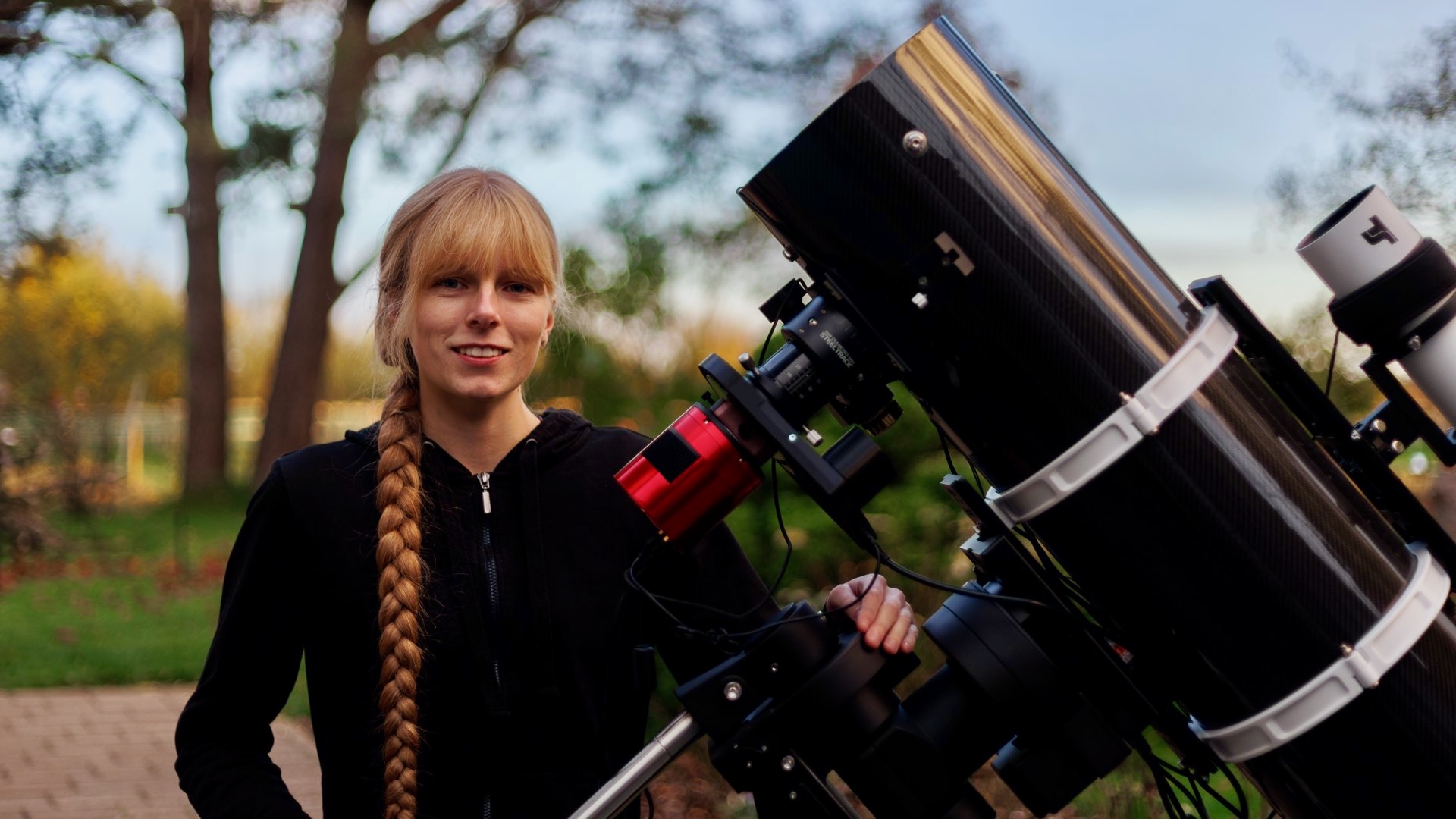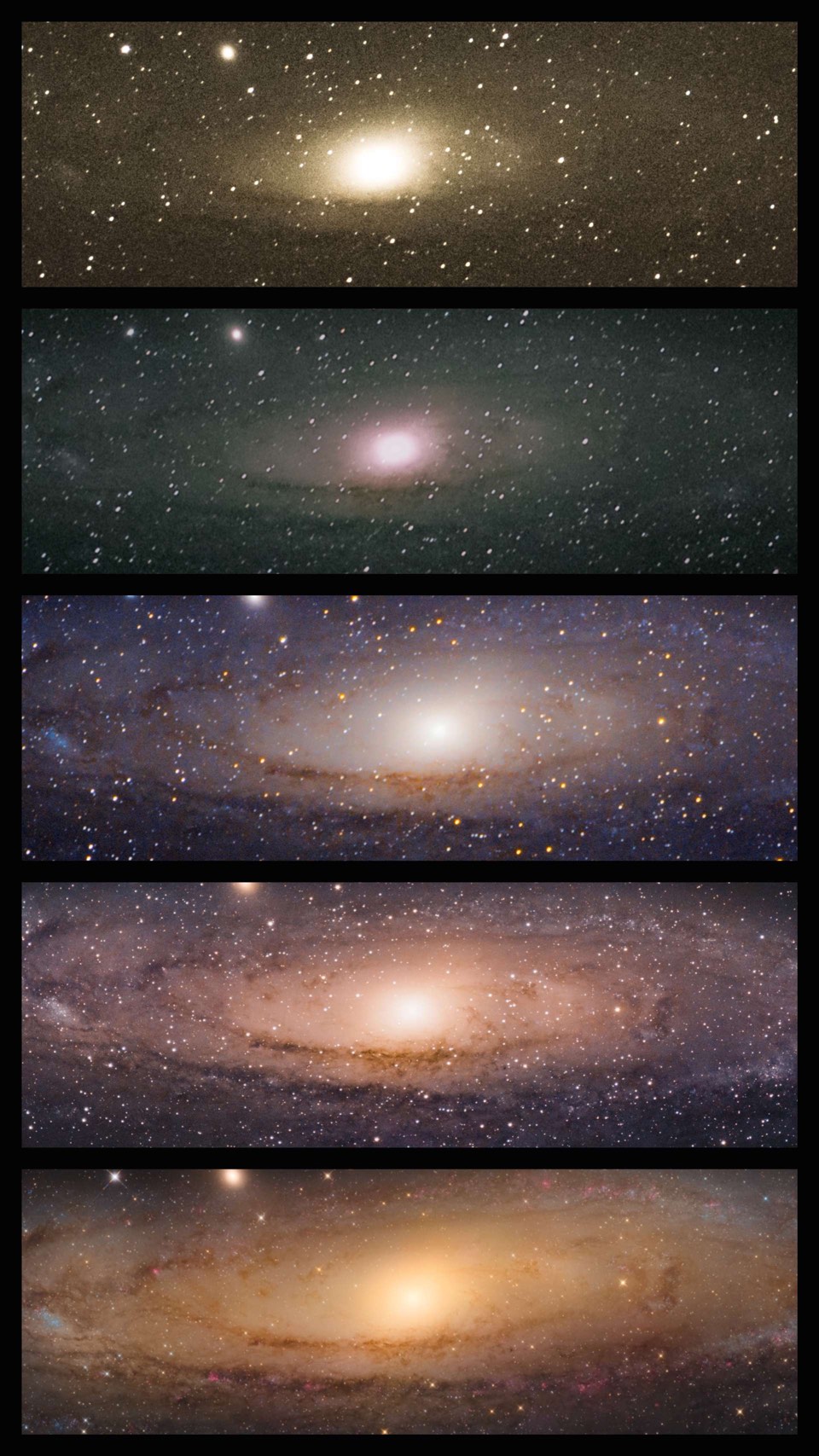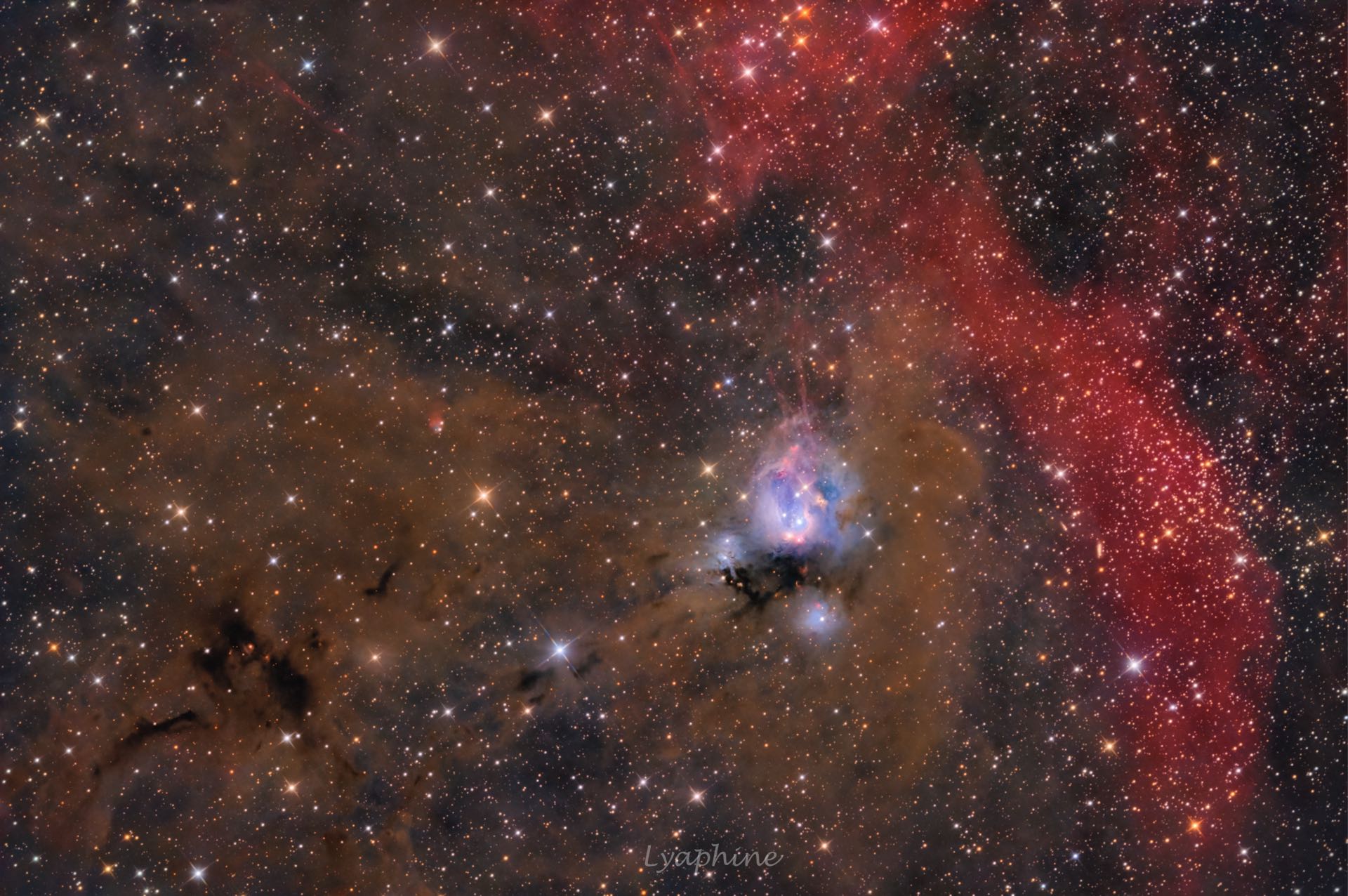Animal portraits by day, nebulae by night: an interview with photographer Sophie Paulin
Sophie Paulin started photography during the coronavirus pandemic and quickly developed into a distinguished astrophotographer.

Since then, she has discovered a previously unrecorded nebula. From beginner to professional in less than three years - how did she manage that? The young IT engineer from Bobingen, Germany has a contagious enthusiasm, and in conversation we quickly learn that if Sophie puts her mind to something, then it is all or nothing.
Sophie, the night sky has gripped you, and does not seem to want to let you go. Where did this fascination come from?
I have a great interest in the natural sciences that was probably awakened by my grandfather. He was a Doctor of Chemistry, and when we went on long walks together, he told me all about the stars. I found it incredibly fascinating at the time. Astrophysics was my favourite subject in high school, and it would have been very interesting to study. Unfortunately, this was not possible in Augsburg, and it would also have been difficult to find work as an astrophysicist afterwards. Thanks to my degree in engineering informatics, I was able to find a job immediately, and so I can finance my passion for astronomy.
You weren’t even thinking of photographing stars at first.
I bought a SLR camera during the pandemic to make videos of my dog Spotty, an Australian Shepherd who had mastered over 200 different tricks. Then I saw an image of the Andromeda Galaxy taken with the same 200mm f/2.8 lens that I also use. I had to try that. That was in May, not exactly the best month for an autumn constellation. So I stood in a field and waited half a night until finally, at 3am, Andromeda was high enough in the sky for a first photo.
Today astrophotography is your great passion. How does this fit in with animal photography?
I would say that there is definitely a connection. Ultimately, they are both concerned with nature photography, even if we usually narrow that term. Landscape photography belongs to the category nature photography, which quickly takes us to nightscape photography. It’s then only a short step to astrophotography. Animal portraits by day, nebulae by night (laughs).
Then you photographed Andromeda again and again. Your progress is striking.
Yes, M 31 has become a kind of anchor for me in the night sky. I have photographed the galaxy five times, and it is always the first object I tackle whenever I get new equipment. After the 70-200mm telephoto came a 600mm telephoto and then my first telescope.
 The Andromeda Galaxy M 31, photographed by Sophie Paulin. 2x without tracking with 200mm telephoto lens, 1x with camera mount and 200mm telephoto lens with telephoto converter, 1x with camera mount and 600mm telephoto lens, 1x with 8" f/4.5 Newton telescope.
The Andromeda Galaxy M 31, photographed by Sophie Paulin. 2x without tracking with 200mm telephoto lens, 1x with camera mount and 200mm telephoto lens with telephoto converter, 1x with camera mount and 600mm telephoto lens, 1x with 8" f/4.5 Newton telescope.Which mount did you use for these first photos?
None at all, just a tripod with a ball head and then 1.5 sec exposures, I pressed the shutter button myself. I stacked the single images; you can see the result in the first of the five Andromeda photos. Then came the camera mount and finally my telescope. I took the last photo in October 2021, which is already a while ago. I would like to create another image sometime, using my current equipment.
What was your first "real" telescope?
That was the 8-inch f/4.5 ONTC Newtonian from TS, which I still use today. At first, I simply screwed the SLR onto it - that was it. I just take pictures from my terrace, we have a Bortle 4 sky here, which works well for photography. Of course, for visual observations I would have to go to the Alps, but I haven't done that much so far.
You are not afraid of long exposure times, this requires discipline. If the weather is right, you must get outside. How do you motivate yourself? Can that be difficult?
I don't need long to set up, otherwise it wouldn't work at all. I keep the telescope outside under the shelter of the roof, and it only has a cover over it, so it doesn't need time to cool down. I simply push it out, adjust the mount and I’m ready to go. The mount is a CEM 70 from iOptron, a camera is built into the polar finderscope, so aligning north is super-fast.
What makes a good astronomy photograph for you?
I must like it (laughs). In theory: no gradients, low noise, sharp stars, good image composition. A good image composition is not that easy, I can only adjust the centre of the picture, cropping and rotation. But when I manage it, it's cool.
When it comes to objects, are you open to everything? Even planets?
Sure, and I know all the tricks – for planets I even water the terrace, so that the seeing here is right! Everything appears in front of my lens at some point, including the Moon, but since I photograph a lot of nebulae, the Moon and I don't have a very easy relationship (laughs).
How do you find your targets? What appeals to you about objects?
At the moment, I'm photographing things that no one else has taken good picture of yet, and that are also difficult. I have really good equipment, and I want to know what is possible with it. Then the Orion Nebula is no longer a target. Of course, I also look at what others are photographing, and I use astronomical surveys, which you can find easily online. This is also how I came across my current project, which is a planetary nebula candidate for which there is no picture as yet. That looks really interesting.
How did the discovery of your Rebpau1 nebula come about?
The start was an "Astronomy Photo of the Day" of the reflection nebula NGC 7129 in Kepheus. There were those red trails, and I thought: "Does it really look like that?" I want to photograph that! I was simply curious.
And then you spent three months imaging it from your terrace.
Yes, 118 hours of exposure time in total. For the first time in an amateur photo the red trails are clearly visible. And then a friend said: what is this little nebula there, next to 7129? We searched the databases and there was no entry. I had a decent signature in the narrowband images, and when there is oxygen and hydrogen, it's always interesting. We do not yet know what it is, it could be a planetary nebula. It will take some time before the spectroscopy is available. But the nebula bears our name now.
 NGC 7129 and Rebpau1, photographed by Sophie Paulin. Rebpau1 is the suspected planetary nebula in the left third of the image, approximately level with NGC 7129.
NGC 7129 and Rebpau1, photographed by Sophie Paulin. Rebpau1 is the suspected planetary nebula in the left third of the image, approximately level with NGC 7129.Incredible story! A great success, you must be incredibly proud. How long did you expose the single shots?
10 minutes for the narrow band, otherwise I get too many pictures (laughs). Colour images usually take 3 minutes to prevent the stars from becoming over-exposed.
Which astronomy cameras do you use?
I now use colour, mono and a guide camera, and I'm also photographing planets. I use the ZWO ASI 2600 for deep sky. The cameras are connected to an old Windows laptop, I don’t need a great deal of computing power just for storing images.
Astrophotography requires quite specific knowledge. How did you accumulate that? Do you use forums to share information with other astrophotographers?
In the beginning I read a lot, googled, and watched YouTube videos. In the meantime I am on a number of astronomy-tagged Discord servers - modern forums so to speak - and there you can really exchange a lot of knowledge. There you can chat with 10 people simultaneously and get an answer to everything, and through the exchanges you are always getting new ideas. You often have to wait two days for an answer if you post in traditional forums. Discord has a lot of functions, which is a bit overwhelming to begin with. I have been using it for 6 or 7 years now, so I have grown quite used to it.
How important is the later image processing on the computer?
This is a separate thing, I don't know where the enthusiasm for it comes from. Per image, I have invested about 4-5 hours of pure working time plus around two weeks of learning new things. I want to find out how much you can get out of a shot. I have recently collected new data with the equipment I used for my very first photos. Just to find out just what this simple piece of equipment can achieve. And also to see how much I've learned in the last two years.
How did you get on with image processing? Does your profession as a software developer help you with this?
I never actually bought a single book, because no book could ever keep up with the pace of change in software development. Every month something new comes out, you can really only keep up to speed via the Internet. In any case, I really enjoy it. You have to be careful not to adulterate the photos, everything must be reproducible. It is, in the end, about science and not just about beautiful pictures.
Which programs do you use?
Of course PixInsight, and also Astro Pixel Processor and Affinity Photo.
Is your goal now only to take better and better photos of difficult objects, or is a simple astrotracker with a SLR still interesting?
I've only used the 600mm lens for the Sun and Moon since the Newtonian arrived. But I bought a 135mm F/2 lens for wide field shooting, so you can take good pictures because it's so nice and sharp. The lens is fast and perfect for use with a camera mount. I still use this, but it takes more time. With the big Newtonian everything works automatically, it can focus, track and takes the pictures - all on its own. With the SLR, I have to set up everything manually.
Do you have any tips for astrophotography beginners? Which mistake do you regularly see, or would try to avoid?
I often see people who want to get into astrophotography and so buy a cheap Newtonian. But they are then never able to enjoy any success. The tracking is never good enough, as these are mainly visual telescopes that do not focus properly. They never manage to create a reasonable picture, because there are simply too many problems all at once. A SLR and a fast lens are required to get started, then a tracker can be added. First a single image, then stack.
Is it important to start with visual observation?
Not necessarily, with the SLR you get to know the night sky in a similar way. You learn to find the objects, star hop and so on. That's why it works so well as an entry point, you can learn slowly in individual steps.
Can you reveal a few targets that are on your agenda?
I am working with a partner to install a telescope in Spain that we can access remotely. The weather in Germany significantly limits observation time. And then comes my new Dobsonian, a 20-inch f/3.2, which gathers a lot of light. It allows me to capture images in less than a second. With this I want to outsmart the seeing and try out some deep sky lucky imaging. The only problem then is the number of images, with 5,000 or 10,000 single shots, my PC will soon be the blocking point (laughs).
Sophie, thank you very much for the conversation, we are very curious what you will achieve with it!
Me too, I’m pushing my boundaries again.
Links
You can find more about Sophie Paulin and her astronomy photographs on her website, on Instagram, Astrobin or on the darkmatters Discord server.
